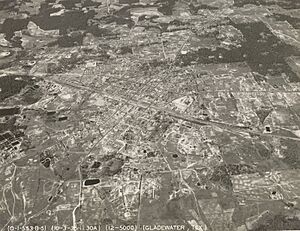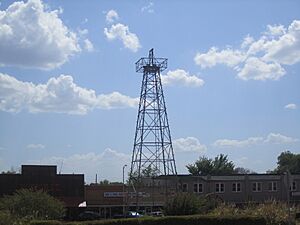Gladewater, Texas facts for kids
Quick facts for kids
Gladewater, Texas
|
|
|---|---|
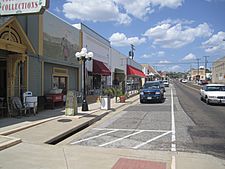
Antique shops in Gladewater
|
|
| Nickname(s):
Antique Capital of East Texas
|
|
| Motto(s):
"Treasuring the past, while embracing the future"
|
|
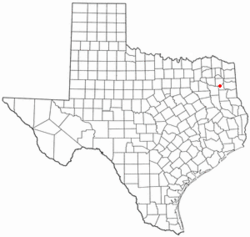
Location of Gladewater, Texas
|
|
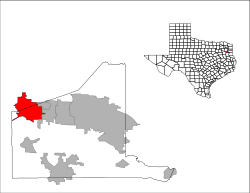 |
|
| Country | United States |
| State | Texas |
| Counties | Gregg, Upshur |
| Incorporated (town) | 1873 (dissolved 1878) |
| Incorporated (city) | 1931 |
| Government | |
| • Type | Mayor-Council |
| Area | |
| • Total | 12.09 sq mi (31.32 km2) |
| • Land | 11.57 sq mi (29.96 km2) |
| • Water | 0.53 sq mi (1.36 km2) |
| Elevation | 341 ft (104 m) |
| Population
(2020)
|
|
| • Total | 6,134 |
| • Density | 507.36/sq mi (195.85/km2) |
| Time zone | UTC-6 (Central (CST)) |
| • Summer (DST) | UTC-5 (CDT) |
| ZIP code |
75647
|
| Area code(s) | 430, 903 |
| FIPS code | 48-29660 |
| GNIS feature ID | 2410592 |
Gladewater is a city in Texas, a state in the United States. It is located in both Gregg and Upshur counties. In 2020, about 6,134 people lived there.
Gladewater was once a busy oil boom town in the early 1900s. Today, it is known as the "Antique Capital of East Texas." The Texas Legislature gave it this special title in 1995.
Contents
History of Gladewater
Gladewater was started in 1873 by the Texas and Pacific Railway Company. They bought land from Jarrett Dean and Anderson White. Other nearby communities, like St. Clair and Point Pleasant, moved to Gladewater. This happened because the railroad decided Gladewater would be the only mail stop in the area. The first post office opened on August 22, 1873. The city's name likely comes from Glade Creek, a stream that flows into the Sabine River. This creek started in a flat, open area called the Glades.
In 1874, Gladewater became an official town with its own government. But this government stopped working. The town didn't get a new official city government until 1931. This was needed because many more people moved to Gladewater. In 1955, the city changed its government style again.
The population of Gladewater grew slowly at first. In 1880, only 163 people lived there. By 1900, there were 259 residents. In the area around Gladewater, lumbering (cutting down trees for wood) was a big business. Farming was also important, and cotton was the main crop. In 1908, the town had several stores, a bank, and mills for wood and cotton.
A major change happened on April 7, 1931. The first oil well in Gladewater started producing oil. It was about 1 mile outside of town. This oil discovery caused the population to grow very quickly. It went from about 500 people to around 8,000 during the 1930s. After the oil boom, in 1940, Gladewater had 4,454 people.
In the 1940s, the city made many improvements. They paved more roads and built a commercial airfield for planes. Between 1940 and 1960, the population grew to 5,742. Lake Gladewater was built in 1954 on Glade Creek. It offers fun activities for people living in the city.
During the 1970s, Gladewater's economy changed. It moved away from relying only on oil. This was because the oil resources in the area started to run out. By 1980, Gladewater had 6,548 residents. The economy in the 1980s still included the oil industry. But it also focused on making things like furniture, clothes, paper products, and boats. The lumber and farming industries were still important too.
By 1990, Gladewater became famous for its many antique stores. The city also has fun annual events. These include the East Texas Gusher Days in April and the Gladewater Roundup Rodeo in June. There's also the Arts and Crafts Festival in September and Christmas events in November.
Gladewater even had a minor league baseball team called the Gladewater Bears. They played for the Boston Red Sox in 1935. The old baseball stadium is now a city park.
Gladewater's Location
Gladewater is mainly in western Gregg County and southern Upshur County. U.S. Route 80 goes east about 12 miles to Longview. It goes west about 10 miles to Big Sandy. U.S. Route 271 crosses US 80 in the middle of Gladewater. It goes north about 14 miles to Gilmer. It goes southwest about 25 miles to Tyler.
The city covers about 12.09 square miles (31.32 square kilometers). Most of this area is land. About 0.53 square miles (1.36 square kilometers) is water. The Sabine River forms the city's southwestern edge.
Population Information
| Historical population | |||
|---|---|---|---|
| Census | Pop. | %± | |
| 1940 | 4,454 | — | |
| 1950 | 5,305 | 19.1% | |
| 1960 | 5,742 | 8.2% | |
| 1970 | 5,574 | −2.9% | |
| 1980 | 6,548 | 17.5% | |
| 1990 | 6,027 | −8.0% | |
| 2000 | 6,078 | 0.8% | |
| 2010 | 6,441 | 6.0% | |
| 2020 | 6,134 | −4.8% | |
| U.S. Decennial Census | |||
| Race | Number | Percentage |
|---|---|---|
| White (NH) | 3,920 | 63.91% |
| Black or African American (NH) | 1,167 | 19.03% |
| Native American or Alaska Native (NH) | 34 | 0.55% |
| Asian (NH) | 49 | 0.8% |
| Pacific Islander (NH) | 3 | 0.05% |
| Some Other Race (NH) | 5 | 0.08% |
| Mixed/Multi-Racial (NH) | 371 | 6.05% |
| Hispanic or Latino | 585 | 9.54% |
| Total | 6,134 |
In 2020, the 2020 United States census counted 6,134 people living in Gladewater. There were 2,122 households and 1,283 families.
Back in 2000, there were 6,078 people. Most people in Gladewater were White (79.80%). African Americans made up the second largest group (16.12%). People of Hispanic or Latino background made up 3.50% of the population in 2000. By 2020, the population was still mostly non-Hispanic White. African Americans were still the second largest group. Hispanic or Latino people made up 14.8% of the population in later estimates.
In 2000, the average income for a household in the city was $28,118. For a family, it was $32,278. About 19.6% of all people in Gladewater lived below the poverty line. This included about 24.9% of those under 18. In 2020, the average household income was estimated to be $40,000.
Education in Gladewater
Most of Gladewater is part of the Gladewater Independent School District. This is where the Gladewater Bears sports teams play. A small part of the city in Upshur County is in the Union Grove Independent School District.
The schools in Gladewater include:
- Gladewater Primary School
- Weldon Elementary School
- Gladewater Middle School
- Gladewater High School
- Truman W. Smith High School
Other school districts that serve parts of the city are:
- Union Grove Independent School District
- Sabine Independent School District
Students in Gladewater and Union Grove ISD can also attend Kilgore Junior College.
Local News
The local newspaper, the Gladewater Mirror, has been published since 1949. It started as a daily newspaper until 1968. After that, it became a weekly newspaper.
Famous People from Gladewater
Many notable people have connections to Gladewater:
- Michael Bowen, an actor
- Skip Butler, a former football punter for the Houston Oilers
- John Floyd, a former wide receiver for the San Diego Chargers
- Winston Hill, a Pro Football Hall of Fame football player
- Tony Jeffery, a former NFL player for the Arizona Cardinals
- Chris Johnson, a defensive back for the Oakland Raiders
- Joe R. Lansdale, an award-winning author
- Harding Lawrence, a former president of Braniff International Airways
- Daylon Mack, a USFL football player
- Delmonico Montgomery, a football cornerback
- James Scott, a former wide receiver for the Chicago Bears
- John Ben Shepperd, a former Texas state attorney general
- Lovie Smith, a former head football coach for the Houston Texans
- Kelcy Warren, a billionaire oil businessman
See also
 In Spanish: Gladewater (Texas) para niños
In Spanish: Gladewater (Texas) para niños


